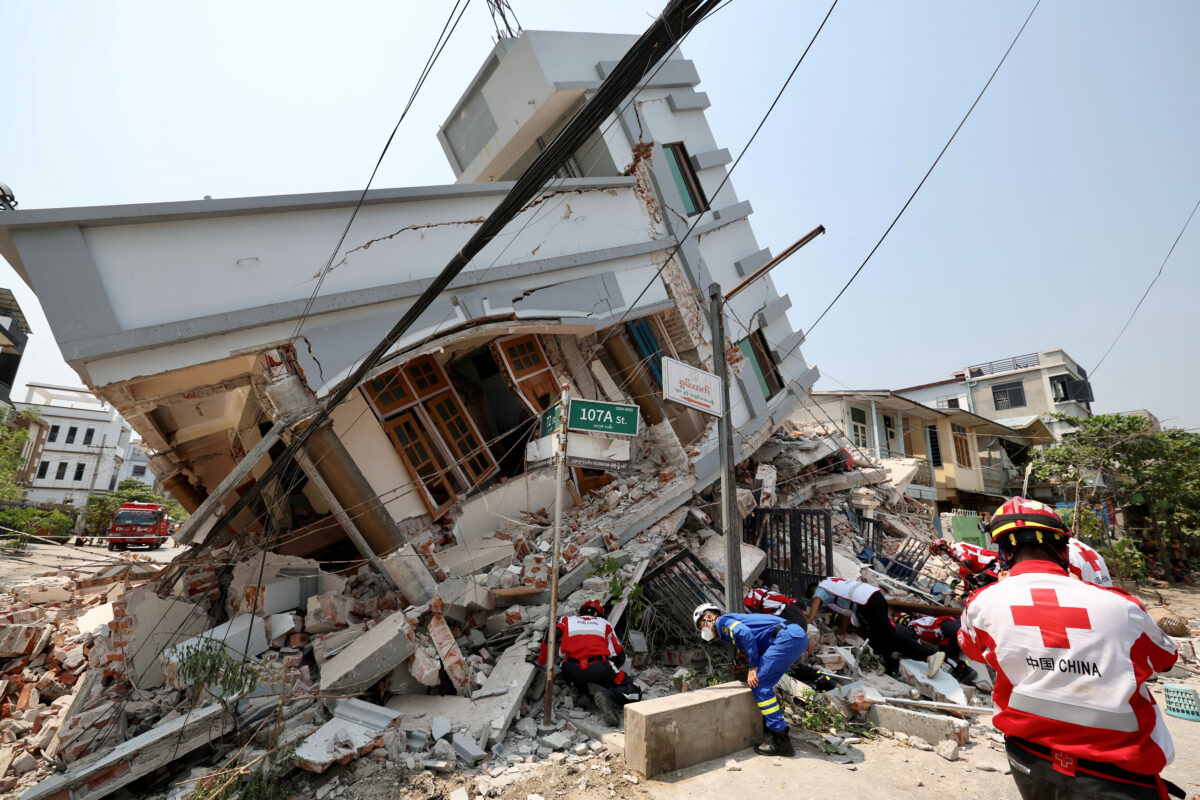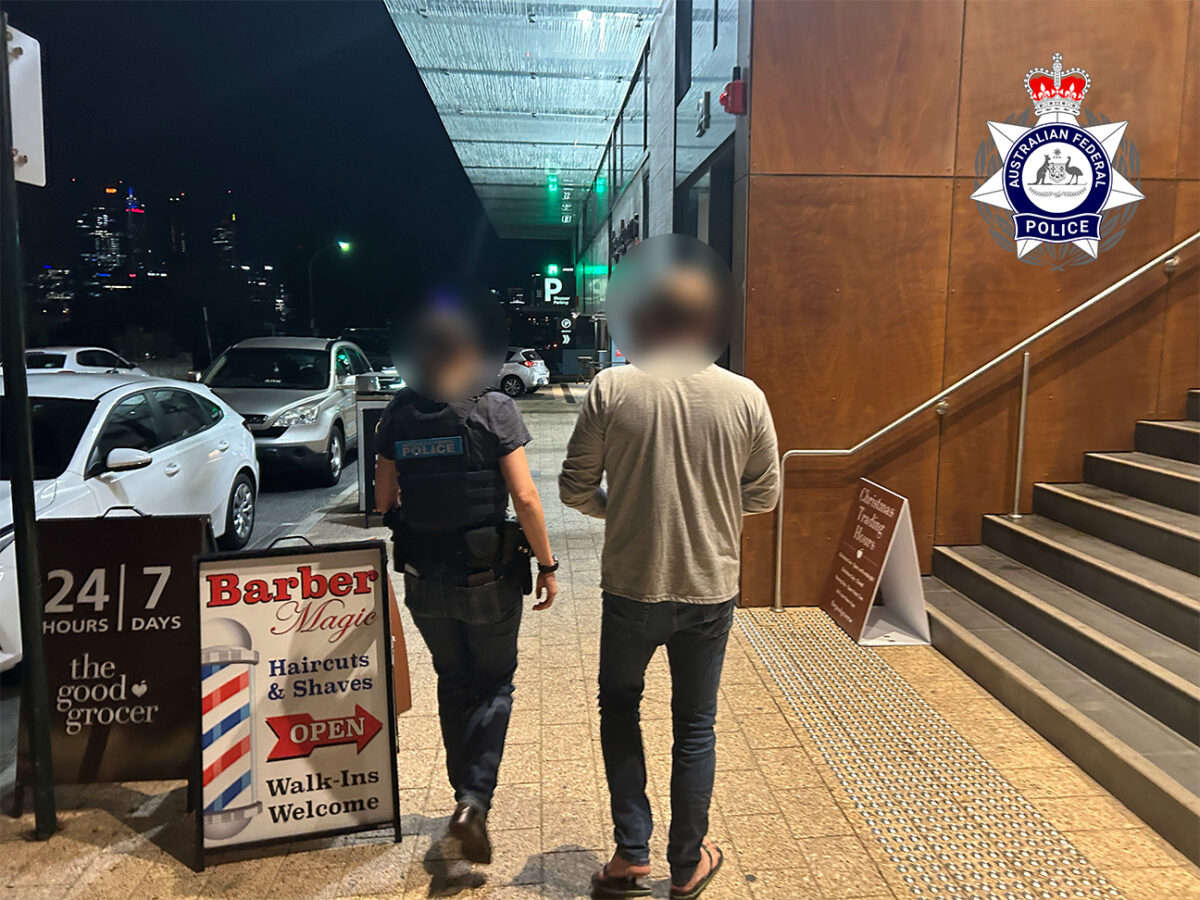Jenin: Open Source Insights on Israel's July Raids
In the early hours of 3 July, 2023, Israel launched a major military operation in the Jenin refugee camp, reportedly one of the largest conducted in the West Bank since 2002.
Multiple videos circulated online as Israeli forces carried out drone strikes and conducted ground raids during the two-day operation.
Bellingcat’s Discord community and researchers examined and verified some of the available imagery and footage circulating online to see what it could tell us about these events.
The Israel Defense Forces (IDF) described their actions in Jenin as a “counterterrorism strike targeting heavily-armed, violent terrorist groups.” They also reportedly claimed to have confiscated thousands of weapons, bomb-making materials and money.
However, the Palestinian Authority described the operation as a war crime.
At its end, at least 12 Palestinians had been killed and thousands had been forced from their homes. One Israeli soldier was also killed.
While there has been widespread coverage of the operation in international media, multiple incidents that took place inside Jenin have either gone unreported or received little specific attention.
Bellingcat analysed two of these events, piecing together what it could using open sources. To be clear, open source evidence of other incidents during the two-day raid exists on a variety of social media channels. These are merely two events that Bellingcat investigators, volunteers and contributors have been able to glean new information about.
Late Night Explosion in Jenin
Multiple drone strikes were carried out by Israel during the two-day raid.
Until recently drone strikes in the West Bank are reported to have been rare, but the IDF told Reuters that drone strikes would “minimise friction” and were based on “precise intelligence.”
The IDF revealed the location of one drone strike it said had disabled what it called an advanced operation and reconnaissance centre for the Jenin Brigades, a Palestinian militant group, although this was not possible to independently verify.
Bellingcat examined a CCTV video of another explosion which was detailed on social media in the days after the raid.
The footage appeared on Telegram and is timestamped 3 July, 2023 at 02:36 in the morning (the video uses the US date format 07/03/2023). The camera is positioned to one side of a building where a man can be seen standing in the entrance, lighting up a cigarette. Two other men can be seen on the corner of the building opposite to the camera. The silhouette of another man is visible further down the street before he disappears out of sight. None of the men appear to be holding weapons in the footage.

A second later there is a blast followed by a flash of dust.
As it clears, one of the men can be seen lying on the ground. The other limps away towards the camera and then falls to the ground. The source of the explosion is not clear from the video alone. But it would likely have happened shortly after the first strikes were reported. The Times of Israel later noted that the IDF operation began shortly after 01:00AM on 3 July with air strikes against multiple targets in the city.
The man who had been smoking moments before the blast dashes out of sight when the dust begins to settle. A fourth man dressed in a dark T-shirt, possibly the man whose silhouette was seen before the blast, comes crawling towards the apartment’s entrance. When he reaches the door, the video stops. Other versions of the video show medics arriving as well as a crowd.
It was difficult to geolocate this video because the angle restricted identification of key structures that could be searched for in satellite imagery.
The only identifiable markers to go by were the door opposite the camera (marked in yellow in the screenshot below) and a drainpipe (green box) next to it. None of these can be seen from above.

On 3 July at 03:30AM local time, the Jenin-based Al-Qassam Telegram channel shared a video from that showed blood visible on the ground and damage that appeared to match what could be seen in the footage.
Several other features in this video also appeared to match.
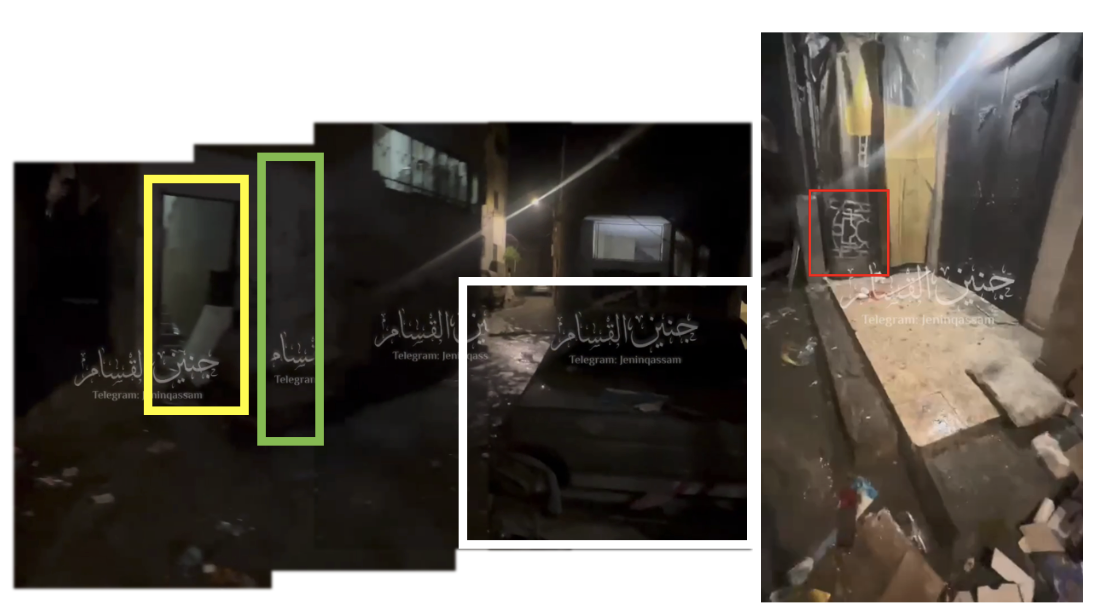
Further footage came from a Palestinian photojournalist who went to the site of the blast the next day during daylight hours.
They posted footage to social media (above) showing more identifying features from the area. This allowed a member of Bellingcat’s Discord community to find the blast site.
The same door (yellow) and drainpipe (in green) are visible in the daytime footage.
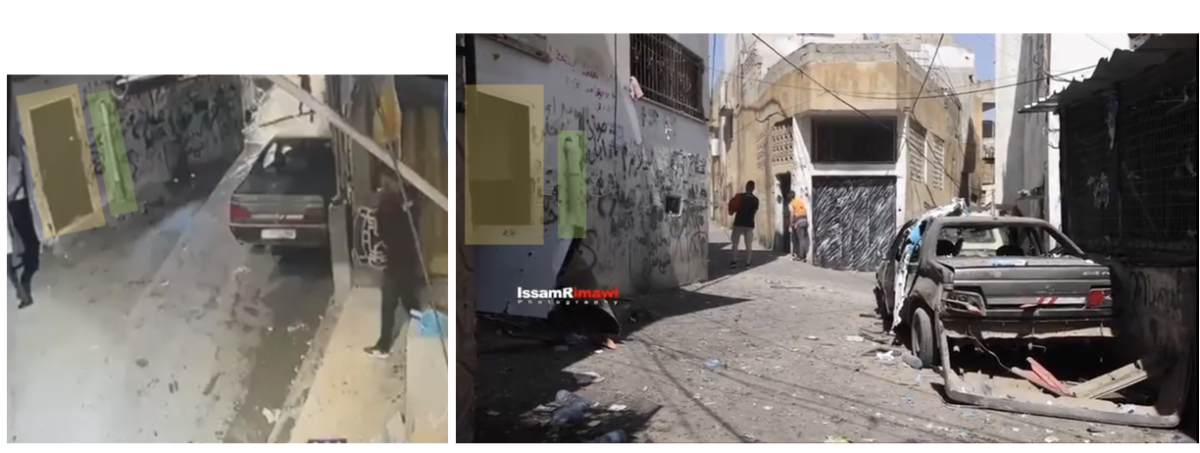
The car on the street can also be matched to the car seen in the video of the explosion.
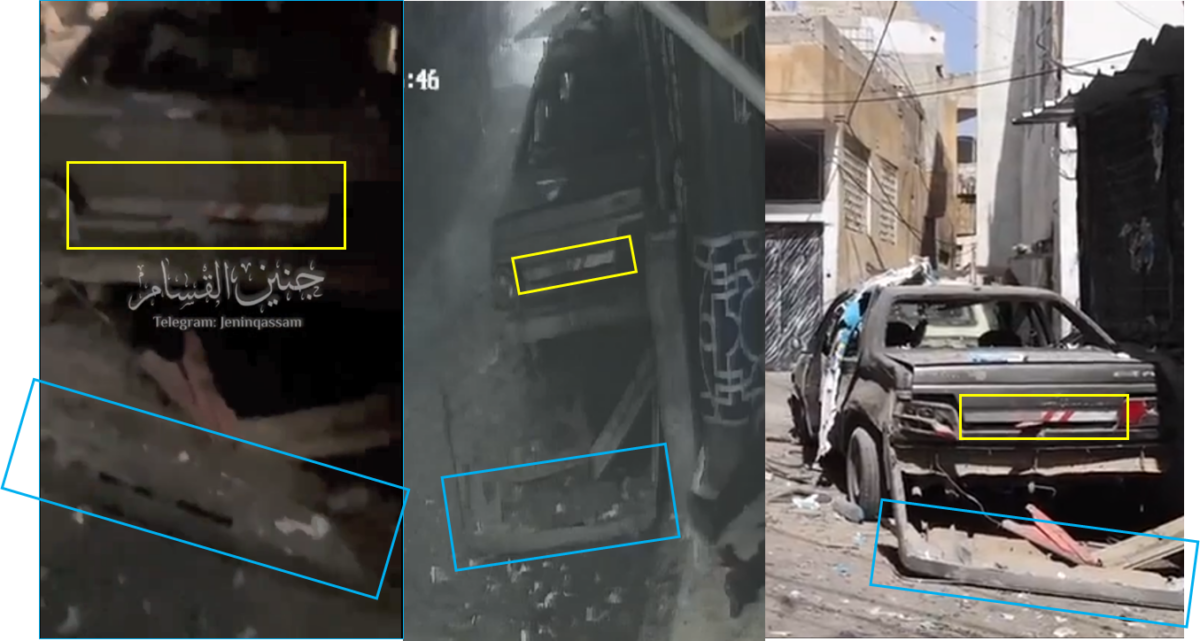
Furthermore, we can see a trapezoid-shaped building at a Y-intersection to the right of the aforementioned door and drainpipe giving us significant confidence that the two videos are indeed showing the same location.
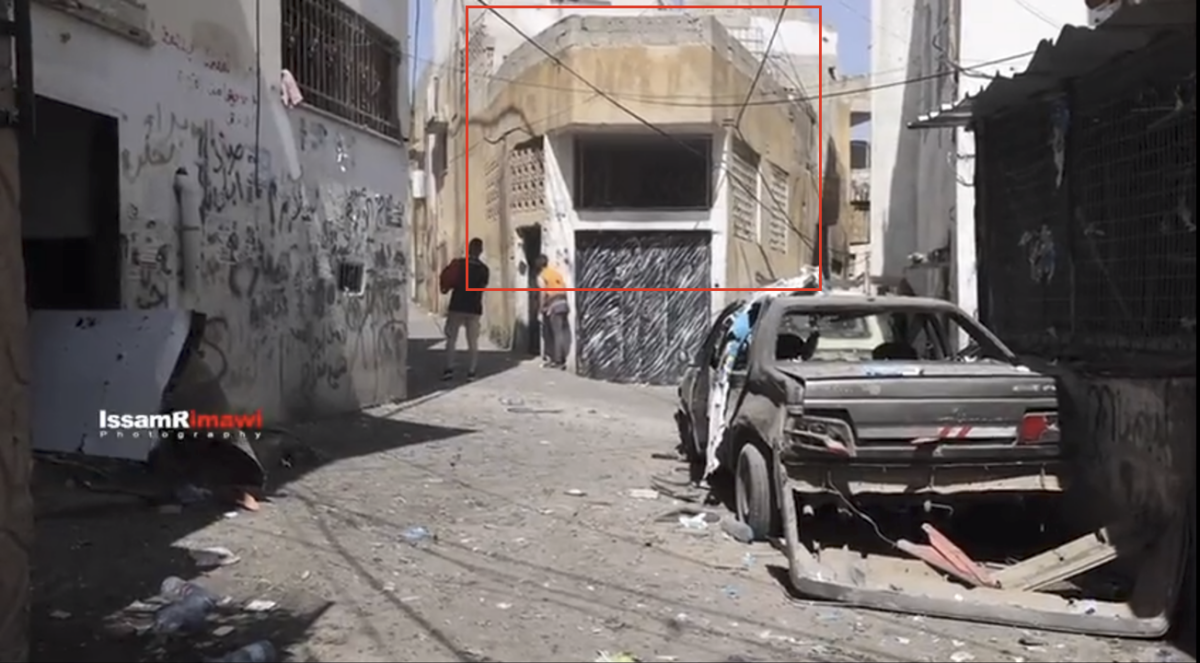

A road leading up to the site of the explosion can be seen in the daytime footage too. The same door, drainpipe and graffiti visible in the CCTV footage can also be seen. Further back (in the image on the right below), more detail of the approaching street can be seen.
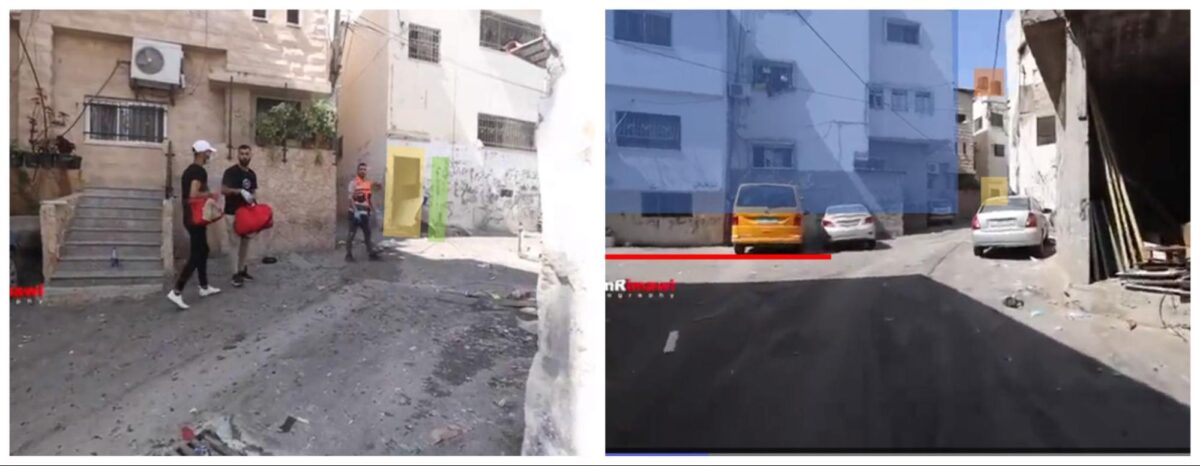
Bellingcat Discord community member Gabor Friesen (@GFLocating on Twitter) was able to match all of these features and find the area on the Israeli government website govmap.gov.il, which has high resolution aerial imagery of the region. Given the strict terms of usage on the govmap site, Bellingcat has chosen to hyperlink rather than embed this imagery. We have used lower quality screen grabs from Google Maps to highlight the area that this video was filmed in as well as the coordinates (32.462315, 35.286059).
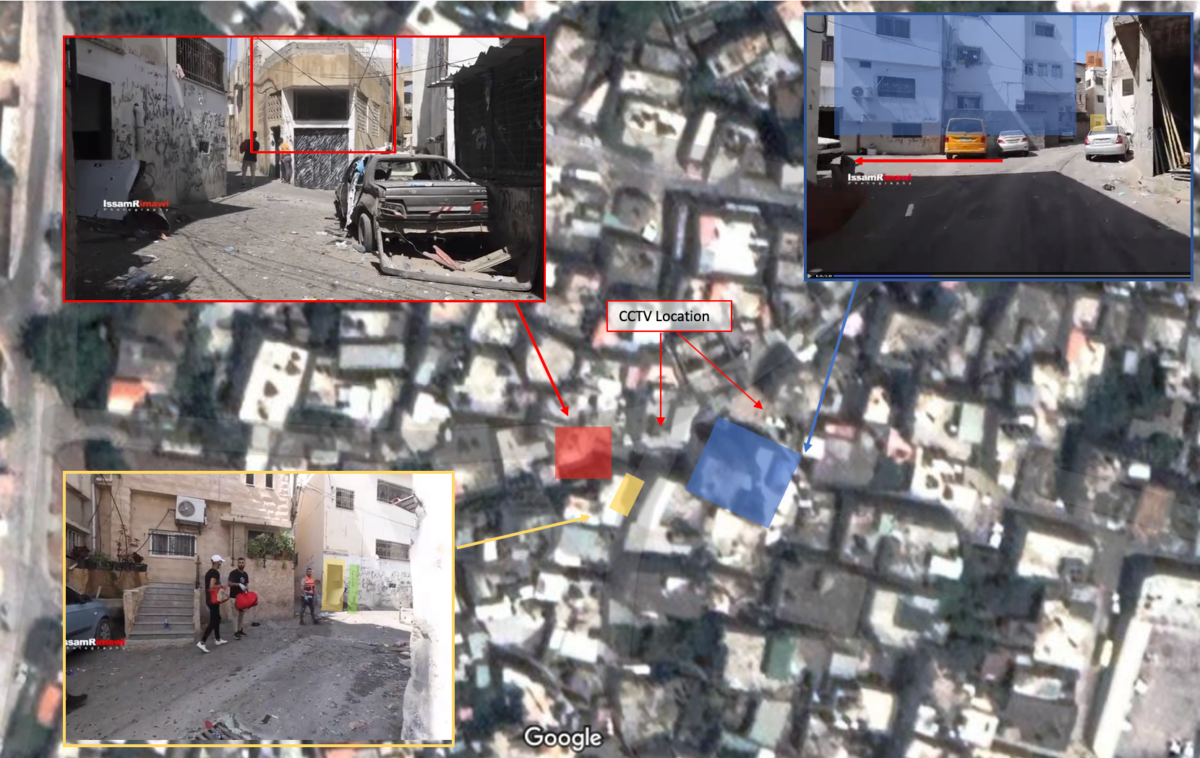
Based on the footage Bellingcat has seen, it appears that several people may have been injured in the blast but we do not know exactly how many people were affected. It was also not possible to identify why this site may have been targeted from the footage alone or that it was definitely a drone strike given only the blast can be seen.
Bellingcat asked the IDF about the explosion and whether this area was hit by one of their drones. We also asked if they knew how many people were killed or injured and why they would have targeted this area, if they had indeed done so, considering how densely populated it is and the possible risk to civilians.
The IDF did not respond to specific questions about this incident but stated that during the raid there were “a limited number of instances when the IDF used fire from the air, when there existed such an imperative operational necessity to do so. Each use of air fire carried out during the activity was examined and approved individually by the senior commanders, and included the taking of many precautions to mitigate harm to civilians.”
Bellingcat also asked the Palestinian Health Authority if it had any information about this incident and how many injuries were recorded but did not receive a response before publication.
Bodies on the Street
The morning after the explosion, social media posts emerged that claimed to show an armoured bulldozer moving through a Jenin street.
Bellingcat found CCTV footage shared to a Telegram channel associated with the Al-Quds Brigade that did indeed show an armoured bulldozer moving along at coordinates 32.459659, 35.291481, with Rémi Vanhumbeeck (@NemoAnno) helping with the geolocation.
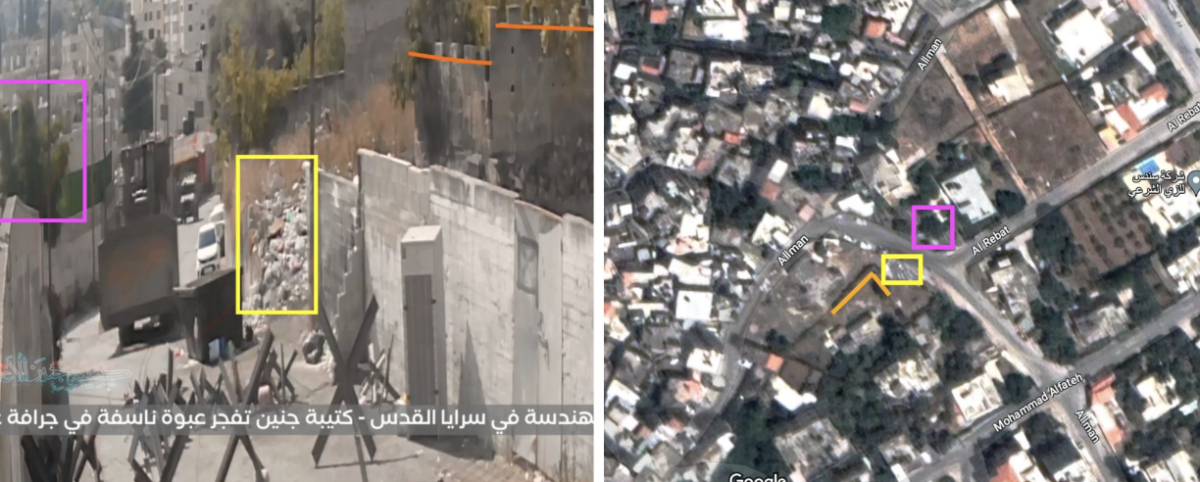
This area is referred to in videos as Al-Damj. However, it appears to be known as Allman on Google Maps. A higher resolution satellite image of this location (as opposed to the one in the image above) can once again be found on the govmap.gov.il site, with the identified features clearer and more pronounced than on other services.
Although the CCTV footage of the bulldozer was only posted on July 8, it matched descriptions and the locations detailed in other videos that had gone live on July 3.
The footage shows an explosion next to the bulldozer as it moves uphill, possibly caused by an IED.
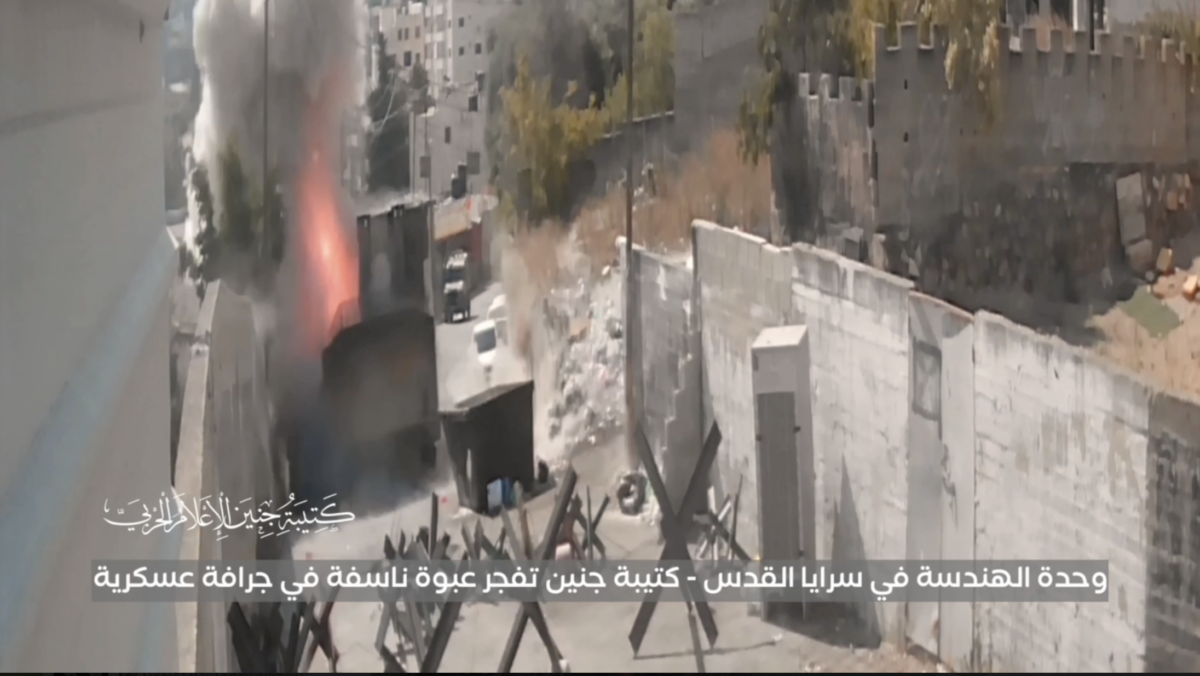
A second video depicting what appears to be the same bulldozer, at the same location, was later posted to the same Telegram channel. This time, the bulldozer appears to have dug up much of the road and some of the surrounding walls have been knocked over or damaged. A projectile can be seen falling near the bulldozer followed by an explosion seconds later.
However, the video ends before it is possible to see if the bulldozer goes anywhere beyond this location.

A visual capture from satellite imagery provider Planet (below) on 8 July showed a yellow and brown area that appeared consistent with the damage to the road seen in the Telegram video.
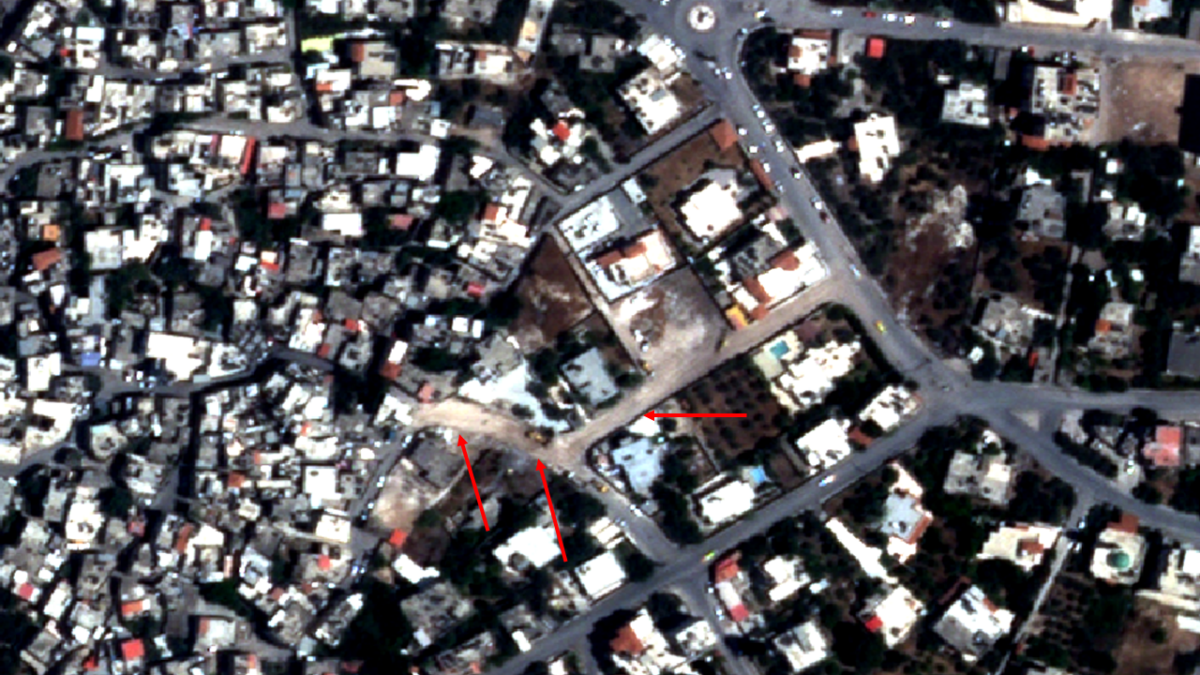
Low resolution satellite images taken on 29 June and 4 July also appeared to corroborate the fact that the street had been damaged between those dates.
Shortly after social media posts about the presence of the bulldozer had appeared, images and video footage of a number of bodies lying motionless behind a car was posted online (between 10:47AM and 10:59AM local time). It was subsequently possible to geolocate this footage to an area close to where the bulldozer had been.
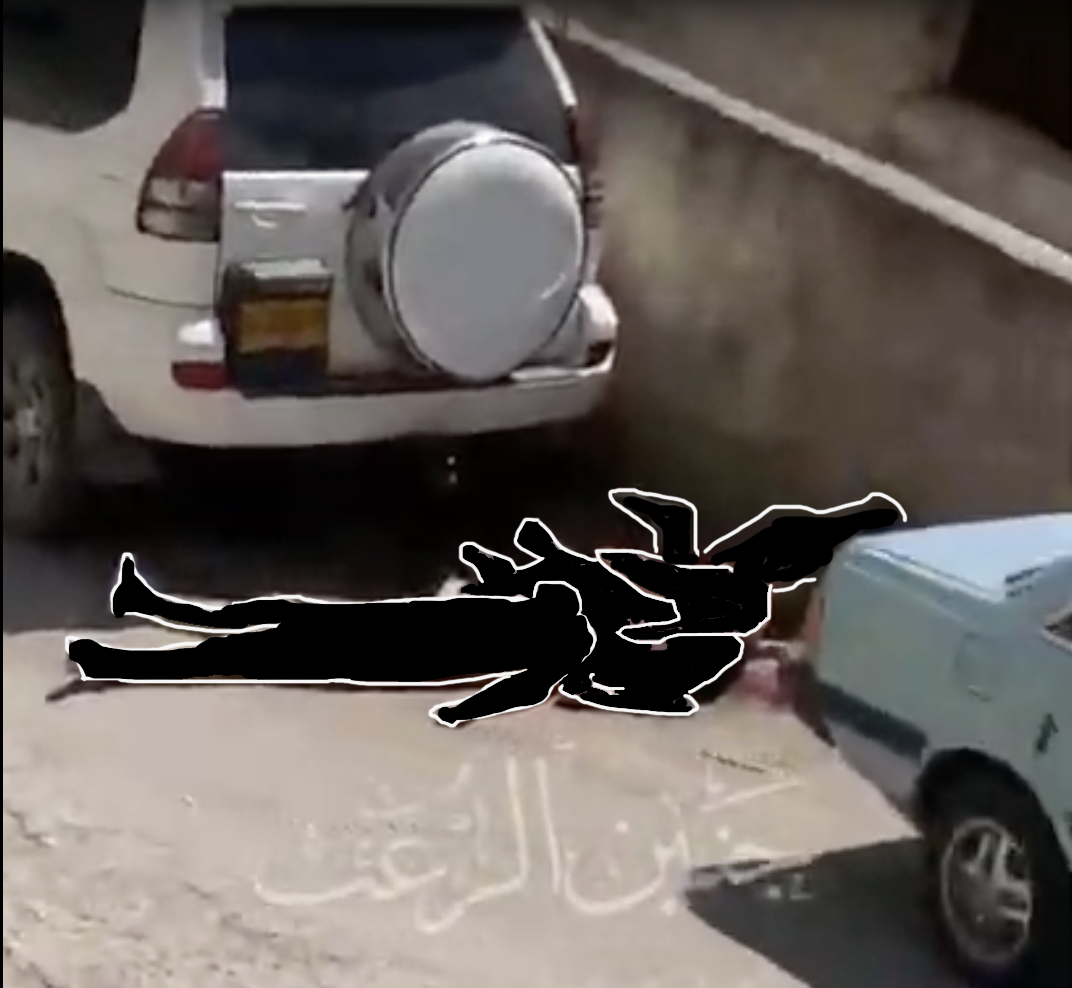
In an effort to try and understand what had happened and whether the two incidents were linked, we further explored social media channels to see if there were any related videos or clues we could glean.
The first recording we found that seemed relevant was posted more than a week later, when a Palestinian Telegram channel shared a CCTV video that appeared to show two men being shot.
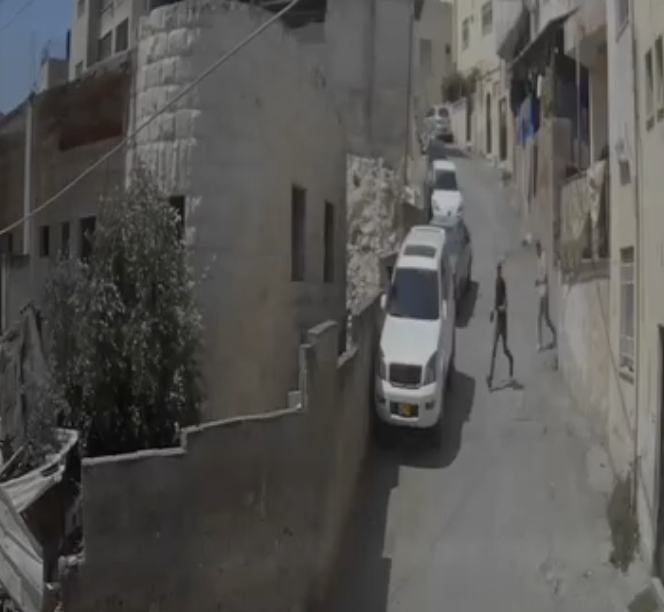
The video was presented by a masked individual in camouflaged clothing who spoke over a series of clips showing the two men. The footage had been cut together with the aforementioned video of a bulldozer at Al-Damj.
According to the masked individual, two men had sought to confront the bulldozer that had been making its way through the area.
It was claimed in other channels that the men were involved in the explosions near the bulldozer. However, this was not possible to immediately verify as it appeared that several separate videos had been cut together and neither man could be seen in the same footage as the bulldozer at any point.
Separately, channels affiliated to the Al-Quds brigades shared videos they said showed one of these men preparing explosives. However, this was also not possible to verify as no faces are visible in the CCTV footage. The Al-Quds Brigade also later said the men seen in the video were affiliated to the group.

In the CCTV footage, one man can be seen wearing a black T-shirt while the other is in a white T-shirt. Both are standing in front of a white SUV and appear to be peering over a wall. Both are visibly trying to keep low and out of sight.
We can tell the CCTV footage is depicting the same area as the previous video that showed the deceased bodies laid out in the street as the parked cars and distinct wall on the left, as well as the tree, helps provide a match (as seen below and geolocated by Chris Osieck (@ChrisOsieck) and Gabor Friesen (@GFLocating).

A satellite image also shows the place where the prone bodies were located compared to where the armoured bulldozer had been. This was indeed just around the corner. A white vehicle also appears visible in the satellite image which was taken on July 8, although it is not possible to say for certain if this is the exact same SUV.
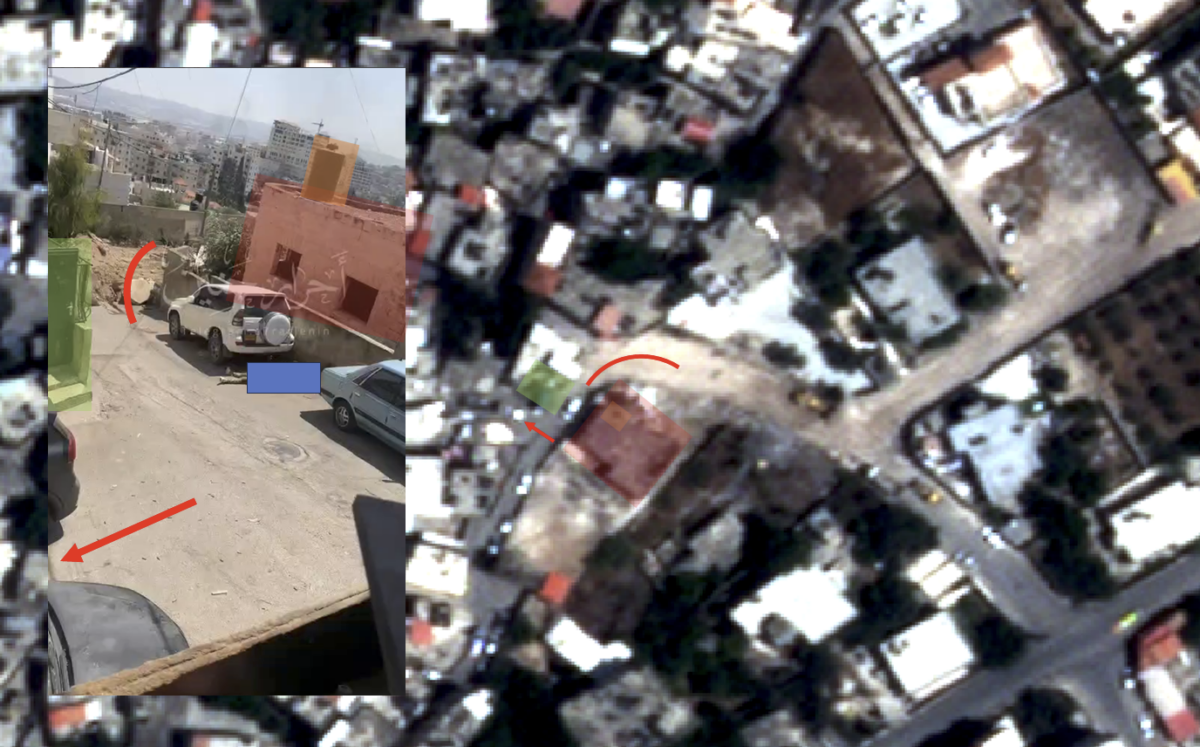
The CCTV video shows the men peeking around the corner. The man in dark clothing is wearing black gloves, and appears to hold a cylindrical object, while the man in the white T-shirt appears to hold another object.
Suddenly, the man in white collapses, while the man in dark clothing runs along the wall towards the SUV and appears to duck for cover. Seconds later, he also collapses.
The object he was holding rolls down the street.
A few seconds later, four men come running out of an adjacent building.
At this point, the footage becomes blurry, possibly to protect the identities of the men by those who shared it, or by those who created the video.
Despite the blurring, it is possible to see that the man in dark clothing is dragged inside a nearby building, while the man in the white T-shirt is dragged by two other individuals behind the white SUV.
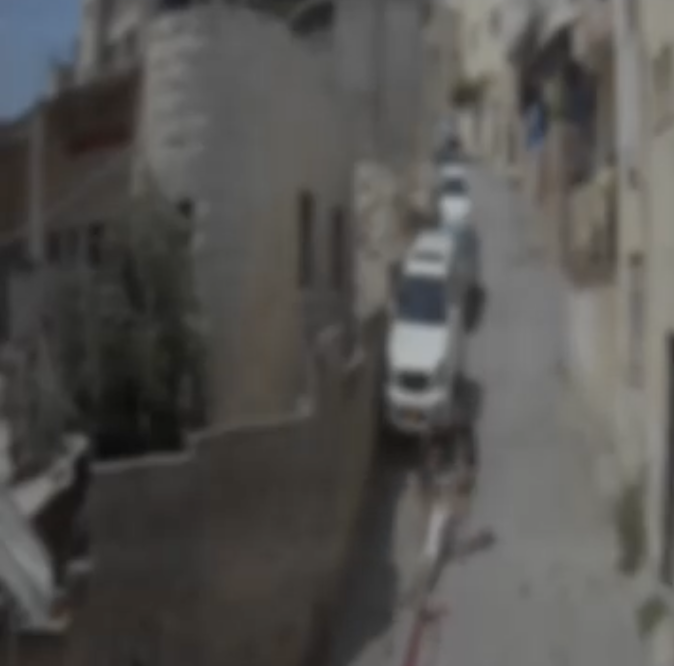
Because the video does not have any original sound, no gunfire can be heard. There are also no visible bullet impacts in the immediate vicinity of the two young men.
From the available open sources, it does appear that these men would have been standing around the corner from the bulldozer if they were indeed there at the same time.
The three men seen in later Telegram images and footage are also laid out in the same place that the man in the white T-shirt was dragged to (behind the white SUV) after he appeared to be shot in the CCTV video.
Bellingcat asked the IDF about the three bodies seen at the site and whether they had been targeted by Israeli forces.
The IDF did not respond directly to these questions but stated that “throughout the activity in Jenin, the IDF forces operated in a dense and complex area, embroiled with Palestinian armed militants, who used heavy fire, explosive charges, and other means of warfare against IDF forces.”
They added that “IDF forces acted to minimise harm to civilians and civilian property to the extent feasible, and were instructed on that matter prior to the activity.” All IDF actions, they said, were conducted in a “precise and confined manner.”
Bellingcat asked the Palestinian Health Authority if it had any details about this incident and the number of people impacted or killed but did not receive a response prior to publication.
Ongoing Raids
Multiple armed clashes between the IDF and Jenin Brigade fighters were reported during the July raid.
As reported by the BBC and Times of London, one unarmed 16-year-old was killed by an Israeli sniper outside a hospital. While Israel said he was linked to armed groups and he was claimed as a member by Islamic Jihad, the boy’s family have strenuously denied this.
Although the raids have drawn criticism from the likes of UN chief António Guterres, who said that escalation was “not the answer,” and called on Israel to use only “proportional force,” Israeli officials have said that the latest incursion into Jenin is unlikely to be its last.
So far this year, the BBC reports that 140 Palestinians – both civilians and members of armed groups – have been killed by the Israeli military or settlers in the West Bank. The BBC also reports that 24 Israelis, two foreigners and a Palestinian worker have been killed in attacks or apparent attacks by Palestinians in Israel and the West Bank. All were civilians except one off-duty serving soldier and a member of the Israeli security forces, the BBC states.
On July 31, the Times of Israel reported that IDF troops had once again entered Jenin.
_________________________________________________________________________________________
Youri van der Weide and Foeke Postma of Bellingcat, along with Chris Osieck, Gabor Friesen and Rémi Vanhumbeeck from Bellingcat’s Discord community, conducted research for this article.
Bellingcat is a non-profit and the ability to carry out our work is dependent on the kind support of individual donors. If you would like to support our work, you can do so here. You can also subscribe to our Patreon channel here. Subscribe to our Newsletter and follow us on Twitter here and Mastodon here.

